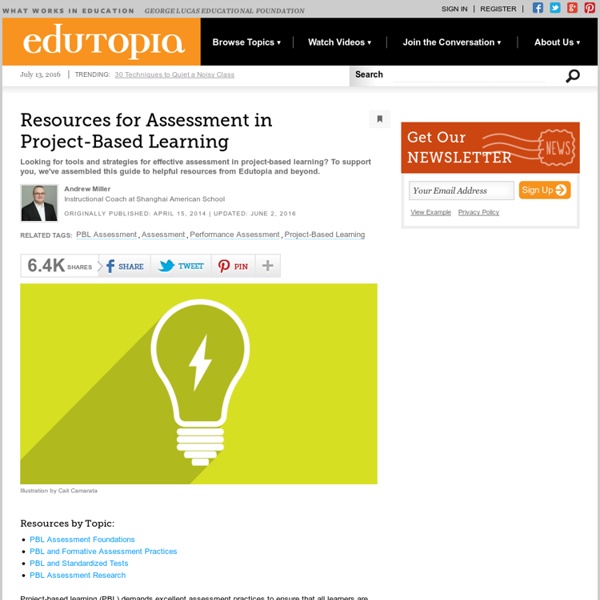Creating a Classroom Library
Here's how I organized my classroom library. There is no right or wrong way to organize your library and these ideas are simply how I choose to organize mine. Just below is a picture of my second grade library in progress. It is amazing how it transforms! I have combined my library and my meeting area.
edutopia
Discover Benefits of Community and Business Partnerships How Can High-Poverty Schools Engage Families and the Community?: Learn about the benefits when high-poverty schools engage with community partners for support, resources, and guidance.
34 Strategies For The Stages Of Assessment: Before, During & After -
34 Strategies For The Stages Of Assessment: Before, During & After by TeachThought Staff For professional development on assessment, contact us today. The follow graphic from the infographic-famous Mia MacMeekin offers 34 strategies for each stage of the assessment process–before, during, and after. Rather than simply repeat them from the graphic, we’ve give a quick primer on the differences between each stage in terms of its purpose/function in the learning process.
The Difference Between Assessment Of Learning And Assessment For Learning -
The Difference Between Assessment Of Learning And Assessment For Learning by Terry Heick What is the difference between assessment of learning and assessment for learning? It boils down to purpose. In 50 Ways To Measure Understanding, I talked about the purpose of assessment: Is the assessment for the teacher or the student?
Transformation Central - Project-Based Learning
These teacher-developed Project-Based Learning Units are intended as an idea-generation resource, as these units may reflect alignment to outdated standards. Please consider alignment and adjust these units to current standards prior to classroom implementation. Check out our PBL Online Workshops! Archived PBL These units have been archived and will no longer be updated. Transformation Central does not guarantee the alignment to the TEKS or state assessment.
Level the playing field
Veteran journalist and documentary filmmaker Soledad O’Brien tells how technology can help overcome barriers and close achievement gaps. “Education is the next civil rights,” said Soledad O’Brien in her opening keynote address at ISTE 2015. This story appears in SmartBrief’s digital publication, SmartReport on ISTE 2015. To see more features, tips and our Tech Showcase, download it now.
edutopia
School 21 infuses the arts into a project-based learning model, emphasizing personalized learning and redrafting multiple revisions in the process of iteration. This London-based public school teaches students from Reception through Year 11 (approximately pre-K to 11th grade), and will ultimately serve through Year 13. At the secondary level (Years 7 through 11), each PBL unit is co-taught by a core academic subject teacher and an arts teacher. School 21 believes that integrating the arts and PBL is a natural fit. "I would argue that the arts is project-based learning," says Emily Crowhurst, a music teacher.
How do I use the Korthagen reflection circle diagram?
The Korthagen methodology (2002) is mainly used to examine how you operate in your professional life. Sources: Korthagen, F.A.J. & Vasalos, A. (2002). Niveaus in reflectie: naar maatwerk in begeleiding. VELON-Tijdschrift voor lerarenopleiders, 23(1), p. 29-38. Creating alternative methods of action Trial and Action Action/Experience Looking back Awareness of essential aspects Phase 1: Describe the experience/situation you wish to reflect upon.
How I Use How-To Videos in the Classroom
I would imagine most people have watched a how-to video on something—a cooking technique, home repair, or craft project. I know my music students watch similar videos; many days students have come to class proud to play the new songs they learned from YouTube: “The Pink Panther,” “Star Wars Main Theme,” and even the saxophone solo from “Careless Whisper.” This ’80s girl was proud! It got me thinking: Since students love to watch how-to videos, what if they could create them, too? The project had success written all over it. The students could demonstrate a skill necessary for class, requiring them to know it well enough to teach others.
Professional Goal: Dive Into Project-based Learning - Philip Cummings
I love that my school is deeply committed to providing teachers with quality, on-going professional growth and development. Among the many things we do each year at PDS for professional development, teachers create an individual professional development goals directly related to classroom teaching and learning. Each goal should have practical application and impact in the current year and align with broader institutional goals and philosophies. Having spent a significant amount of time reading and researching about project-based learning, I decided to commit to diving into PBL this year.
I-PICK Book Tasting
Before I get any farther with this post, I need to give credit where it’s due: thanks to Mr. Plemmons at Barrow Elementary for inspiring this lesson! You can read more about his I-PICK activity here. At our school, teachers use a framework called the Daily Five for literacy instruction in their classrooms. One component of Daily Five is teaching students how to choose good-fit books.



